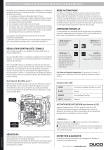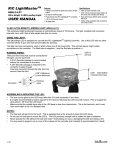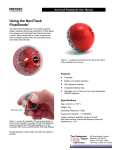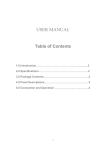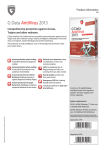Download Fact sheet
Transcript
Sternenstrasse 12 CH-8002 Zürich +41 44 500 43 78 TRANSLATION: The translation of this fact sheet is provided by climatop with the aim of reflecting in the most accurate way the original German text. In case of interpretation difficulties, please consult the original, valid German text. CO2 balance: dishwashing detergent The CO2 balance shows which dishwashing detergent is most climate friendly. The following dishwashing detergents were analysed: Handymatic powder Handymatic sachet Supreme All in One powder Phosphate-free Standard dosage: 20g; washing temperature 45°C • Standard dosage: 27g; washing temperature 55°C M-Budget Tabs Handymatic Classic Tabs Handymatic Classic powder Standard dosage: 20g; washing temperature 55°C Standard dosage: 20g; washing temperature 55°C Standard dosage: 30g; washing temperature 55°C When using Handymatic Classic Tabs or Handymatic Classic powder, rinse aid und dishwasher salt is necessary additionally. The comparison To compare the climate impact of the different dishwashing detergents, the following comparison unit was chosen: Washing dirty dishes in one rinse cycle using the recommended washing programme. The greenhouse gas emissions were summed up over the whole life cycle of the dishwashing detergents, e.g. from the supply of the detergent substances, to the transportation, the production at the production site, the dishwashing itself, to the disposal of the packaging and the waste water sewage. The results The product comparison shows that using Handymatic powder sachets is most climate friendly. Its climate charge is about 25% lower than the climate charge of the other dishwashing detergents. The main reason for the good climate balance of Handymatic powder sachets is the low washing temperature. Climate friendly dishwashing Climate friendly dishwashing is more than choosing the right dishwashing detergent: • Don’t do things by halves: fill your dishwasher completely • Arrange the dishes in the dishwasher according to the instructions in the user manual. So the water can circulate optimally. • You do not have to pre-rinse the dishes. Just remove left over food with used cutlery. Only buy new dishwashers with energy efficiency class A+. The following pie chart shows where the major climate impact of a rinse cycle occurs. The example rinse cycle uses Handymatic powder sachets and a washing temperature of 45°C. The major impact (>73%) is caused by the energy use of the rinse cycle. About 7% of the climate impact is caused by the production of the dishwashing detergents. The provision of fresh water, the wastewater treatment as well as the transportation only cause a minor part of the climate charge of a rinse cycle. Validity of the factsheet: until 1.1.2012 Climatop / 18.03.2010 © all graphics, photographs and text appearing on this factsheet may only be reproduced with permission of climatop.


